Posted by
Mordy Oberstein
All good things start with observations. In this case, I thought I noticed that Google was showing much longer meta-descriptions towards the top of the SERP. In fact, the more queries I ran the more it seemed that Google was showing longer meta-descriptions at the top of the SERP and shorter ones towards the bottom.
Is this true? Is Google showing longer meta-descriptions for those URLs that rank better?
To find out I analyzed 5,000 keywords… for a month.
Does Google Show Longer Meta-Descriptions for Top-Ranking Results?
Meta-descriptions on the Google SERP are a funny thing. They’re not a ranking factor and often their content isn’t controlled by you as Google usually creates their own descriptions from content found on the page. Still, meta-descriptions are an important part of the SERP and can help stimulate clicks to your site. Thus, when I saw there might be a chance that Google is showing longer descriptions at the top of the SERP, I thought it might be meaningful to have an actual answer (and not just some speculation).
In short, the answer is yes, Google does tend to show longer meta-descriptions at the top of the SERP on desktop (I didn’t analyze mobile).
With that, here’s a top-level look at what I found:
- On average, the meta-description afforded to the desktop SERP’s first five results are 15 characters longer than that of the sixth result and 18 characters longer than the 10th.
- Descriptions for results on queries that reflect an informational intent are generally longer than when the query reflected a commerce or local intent. In specific, for informational queries, the meta-description of the first result is 15 characters longer than the first result on local queries and a whopping 41 characters longer than the first result’s description on commerce SERPs.
- Micro-intents appear to matter. For example, for queries that reflected a local intent, the average description length of the first result and second results are 181 and 182 characters respectively. When looking at local queries related solely to hotels the description of the first and second result are 188 and 208 characters respectively.
One quick note on this and on the data below. I am aware that meta-descriptions are measured in pixels. However, “characters” are far more tangible. That’s all I’m going to say on this well-argued topic.
A Bit on the Data I Used
To see the results and analysis of this study (i.e., to avoid the boring details) you can move on to the next section.
Before I get into some of the limitations, let me explain the data collection process a bit.
I selected 1,250 keywords from each of the following niches: Health, Finance, Travel, and Retail. Meaning, all of the keywords used for this study reflect queries that produce sites on the SERP related to the aforementioned industries. That itself is a limitation in its own right. To that, however, the use of these four industries allowed me to utilize high-authority keywords, both high and low search volume keywords, local and product keywords, informational keywords, and the like. In other words, within these four niches were a healthy mix of various keyword types.
These 5,000 keywords were executed every day for a 30-day period. Accordingly, the length of the meta-descriptions for the top 10 results produced by these keywords was recorded each day during the 30-day period. With that, close to 1.5 million search results were analyzed for their meta-description lengths over the data collection period. The vast majority of these results repeated day after day. In other words, unless a URL was dropped out of the top 10 search results the description length of the URL’s organic result was recorded each day. Should a new URL rank among the top 10 results, that URL’s result was analyzed to determine its description length.
It should be noted, despite their being an organic result, Featured Snippets were not included in this study. When a keyword produced a Featured Snippet as the first result, that result was discarded. The other results (positions 2-10), however, were used. I did not investigate if the presence of a Featured Snippet impacted the description length in the results that followed it. Circa 500 of the keywords used produced Featured Snippets. As such, the top result (the Featured Snippet) in these instances was not recorded. Accordingly, the data to be shown for the first position on the SERP contains 15,000 fewer countings of the description’s length as compared to the other positions studied.
Lastly, the sub-intents within a given intent can display varying description lengths. While I did notice this within hotel queries that are part of a local intent (to be discussed at length later), there may be an endless number of instances and breakdowns that I did not. So while I will present information on various intents, description length can and may vary according to the sub-intent reflected by a query.
Description Lengths on the SERP According to Rank Position: What the Data Says
As I mentioned initially, position does seem to play a role in the length of a search result’s description. More specifically, it would appear that certain ranges of positions tend to offer longer meta-descriptions than other position ranges. Based on the data I collected, the top half of the SERP (positions 1-5) are generally afforded longer descriptions than the bottom half of the SERP:
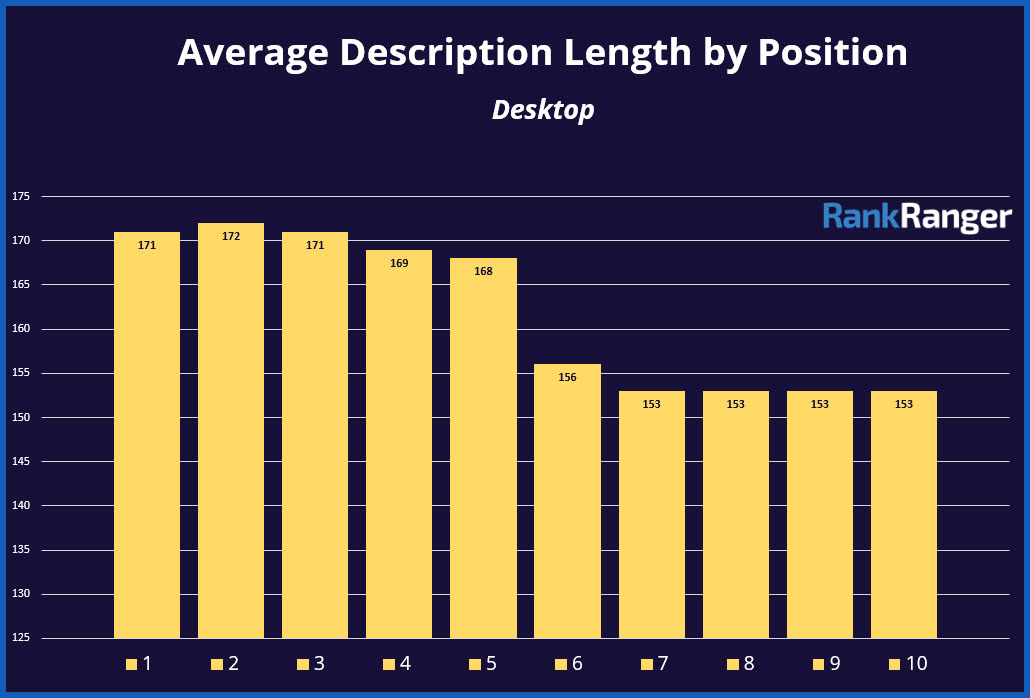
While there is some drop-off between the description length of the results ranking at positions 1-3 and those ranking at positions 4-5, it’s pretty marginal at best. There is however a clear difference in the length of the descriptions Google is affording the search results ranking at positions 1-5 relative to what it affords the results ranking in positions 6-10.
For the record, the average description length shown above, in aggregate, matches the average description position we track daily which reflects an entirely different set of 150K keywords.

The Impact
The obvious impact of this is that meta-descriptions at the bottom of the page offer less incentive to click vis-a-vis the description. This as meta-descriptions are not a ranking factor, but come into play when thinking about clicks. A well-constructed description can and does incentivize clicks. Reading through a description can very much help the user evaluate if the page is relevant to their pursuits. The more characters, the more chance of a reader making the connection between their purpose and your page (all things being equal).
It does put an ever so slight twist on the question of what drives lower CTR as you move down the SERP, is it that the positions are not as visible or that the results are not as relevant? Well, if Google is not affording the same amount of characters to meta-descriptions at the bottom of the SERP you could, in theory, make the argument that by doing so Google is putting its thumb on the scale (slightly) and disincentivizing clicks to lower ranking results. Now, I don’t think this is a major factor on CTR at low ranking positions, but it is an interesting point nonetheless.
Still, not having as many characters offered to your result does affect how users view and relate to it. 15 characters comes to about 4 words on average. That’s not a ton in terms of copy per se. I don’t think those four words make it or break it. But it is an average. Meaning, to me, the trend is almost more important. If Google is showing longer descriptions at the top of the SERP and shorter descriptions lower down, that can look very striking.
Take the query downtown denver attractions. Here’s the SERP once you hit the organic results:
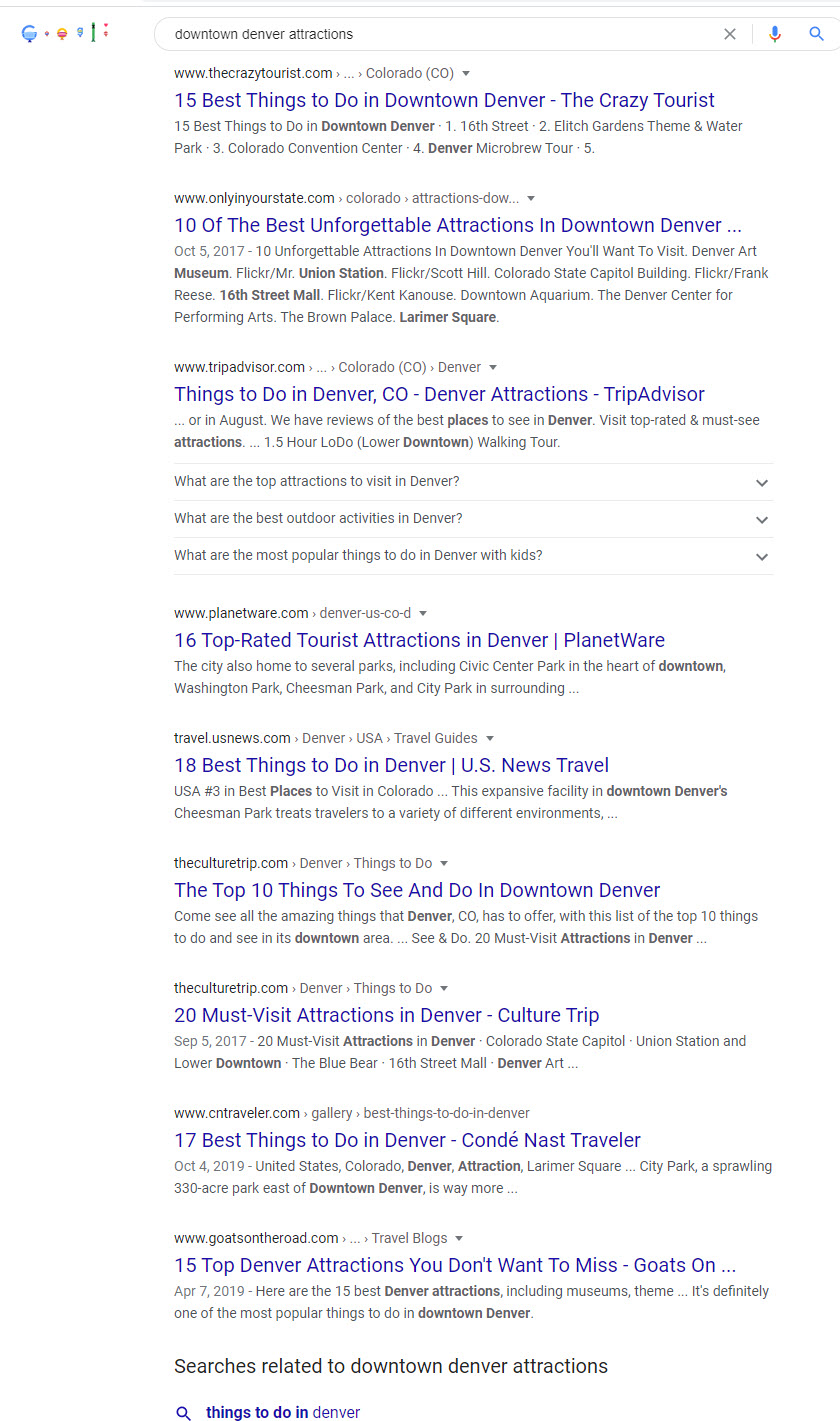
The second result’s description length is about double that of any other result on the page. Forget what it says, it’s how it looks. It makes the result more visible and more importantly it makes the result look more robust as if it has more to offer. In this case, the second result, with its longer description, makes the result that ranks above it look a bit “scrawny.” I think this, the robustness of the results given as a consequence of their appearance on the SERP can play a role in what a user decides to click on. It would be very interesting to dig into that and see if that is indeed the case.
Search Result Descriptions: Average Length per Position and According to Query Intent
It doesn’t take much to see that despite the averages showing a clear description length trend, there is a lot of variance on the SERP itself. I want to see how intent impacts the length of descriptions on the SERP overall and per position. To do this, I extracted keywords from the main data-set and organized them according to informational, commerce, and local intents. Each intent grouping includes 500 keywords related to that intent. Like the main data-set, these keywords had the meta-description length for the top 10 search results recorded each day over the course of 30 days.
{A few notes on the keywords used for each intent category: For the local keywords, I tried to focus on keywords that would generally produce a Local Pack. Meaning, I went more with a keyword like ‘health clinic near me’ than I did with ‘top attractions in London’. Also, the keywords used within the informational category more heavily rely on keywords taken from the Health and Finance niches than they do on keywords from the Retail and Travel niches. For the commerce category, I tried to mainly use keywords that reflect a direct commerce intent. Meaning, I worked to exclude commerce queries where the SERP would be dominated with review sites as I felt that’s too close to an informational intent.}
The data on the average description length of results on the SERP for a specific user intent again points to Google treating the top five results differently than the bottom of the SERP.
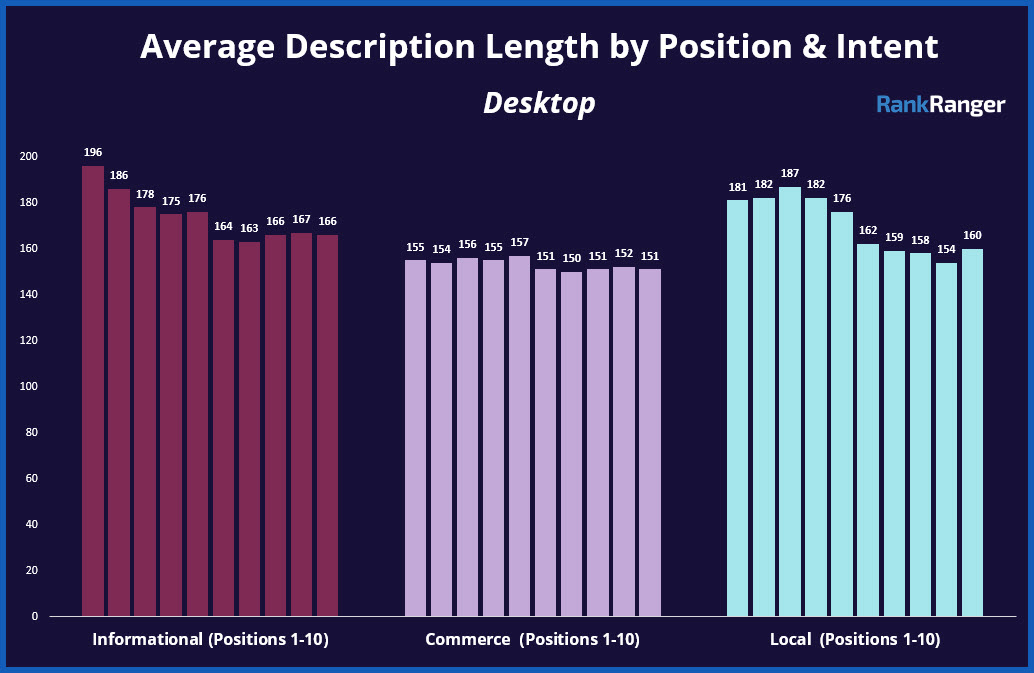
Average description length of search results according to intent type and by position (with the leftmost bar of each element representing position #1 and so forth)
Results on the SERP for both informational and commerce queries show the same exact pattern that the data set presented overall with longer descriptions allotted to the results shown in positions 1-5 and significantly shorter results once you hit positions 6 on the SERP. This points to the accuracy of the notion that Google relates to the top portion of the SERP differently vis-a-vis description length. In other words, that the intent categories shown above present the same exact pattern as the data-set overall (I’ll get to ‘Commerce’ in a moment) removes the possibility that a specific type of keyword skewing the average. (Imagine a case where commerce keywords showed results at positions 7-8 having very long descriptions, longer than higher ranking positions, while local keywords had extremely short descriptions at position 7-8. The data showing a consistent drop-off in description length in the master data-set for those positions would not reflect how Google operates universally. However, with the data as it is, it does appear that Google has a specific approach to description length on the whole.)
That said, you can clearly see that the commerce SERP behaved a bit differently in two ways:
- The overall description lengths are significantly shorter than the other two query categories. For example, the average description length allotted to the first result for commerce queries is 40 characters longer than the average description seen for the first result on the ‘informational’ SERP!
- There is far more uniformity in the description lengths per position on the commerce SERP.
Despite the uniformity, you can still see the overall pattern present on the commerce SERP, just to a lesser extent. Once you reach position 6, the average description length on the commerce SERP dips 4-5 characters. Normally, I would dismiss this as marginal. However, seeing the same pattern within other intent categories and in the overall-data set would indicate that something more purposeful is in effect. It is a good question as to what the conflicting priorities are here. In other words, why does Google limit description length on the commerce SERP and what is causing the dip in length not to be more pronounced? To the latter, I would imagine that once you’re operating with descriptions of just 155 characters at the top of the SERP, how much lower can you really go? That is, Google does treat different parts of the commerce SERP in different ways in terms of description length. It’s just a matter of there not being enough characters to take away if all you have is 155 to work with!
Why Google would limit the description length of the results on the commerce SERP to begin with is a good question. Take the informational category, there the descriptions are generally longer than for queries with a commerce and local intent. All things being equal, that seems to be a logical dynamic. An informational intent intrinsically means the wanting of information so Google gives more of it on the SERP via descriptions of a greater length. Still, that doesn’t answer why descriptions on commerce SERPs and local SERPs aren’t as long as on the “informational SERP.” That is, why not offer more information in the descriptions?
I’ve run a number of queries trying to see if I could determine why Google limits the description length on the commerce SERP as well as why it does not afford the commerce SERP the same description lengths that the informational SERP sees. I don’t have a definitive answer and I am not sure one exists. That said, some possible explanations, based on what I see on the SERP are:
- The content on the pages represented on the commerce (and local) SERP don’t lend themselves to longer descriptions. While the pages represented for informational queries are specifically created to offer more content and specific content with the aim of informing the reader, that’s not the case when a commerce or local query is run. Sites selling products or representing a local business, on the whole, don’t offer the same amount of content from which Google can pull a description. More than that, the nature of the content on these pages doesn’t exactly align with what is offered in a description. Conversely, informational pages do exactly that, offer content that is entirely aligned with what a description is designed to do. In other words, it could be Google shows shorter descriptions for certain intents because the pages these queries produce lack appropriate content.
- It could be that local SERPs see shorter descriptions so as to make enough room on the SERP for ads/PLAs and/or Local Packs, and organic results. That the showing of shorter descriptions is a trade-off between having the results on the page but having enough room for all the SERP features.
Of the two possibilities (of course, there may be other explanations I have not considered), I prefer the first. If it were a matter of SERP features the local SERP would show descriptions as short as the commerce SERP does. While you may not have product carousels on the local SERP (though you often do have PLAs) you have the Local Pack and the Discover More Places carousel, etc.
Further, the idea of their being less appropriate content for a description when a local or commerce query is run is a truth. Take the query buy new shoes online. Here, Amazon’s result (which is the 3rd position on this SERP) gets a description that’s about 130 characters. Have a look at the page being represented here on the SERP and where the description comes from:

There’s not a lot there and what is there isn’t exactly Faulkner.
Local, on the other hand, is a bit different and that might explain why it tends to get longer descriptions (though not as long as what appears for informational queries). As opposed to the product pages produced by direct commerce queries (remember I said I tried to limit queries that would bring up an abundance of review sites) your average local SERP contains sites that produce lists of locations.
Take the query pizza nyc. The top results here reflect lists of local pizza shops:
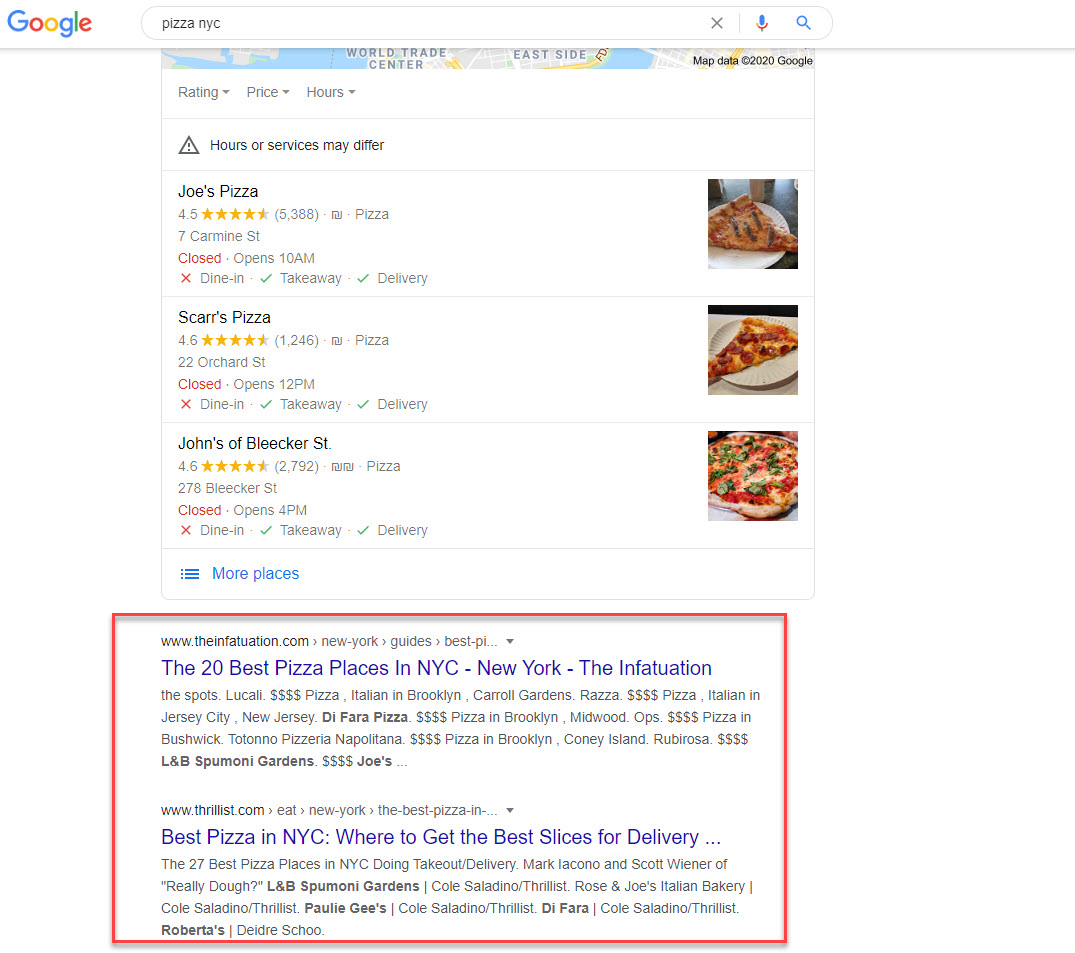
What Google tends to do here is pull the list from the page and utilize it as the description. As you can see above, the descriptions are basically lists of locations and their price range. Forget the effectiveness of this process and whether or not it’s helpful at all, that content is simply not available on most product pages. Go back to the Amazon page for a moment:
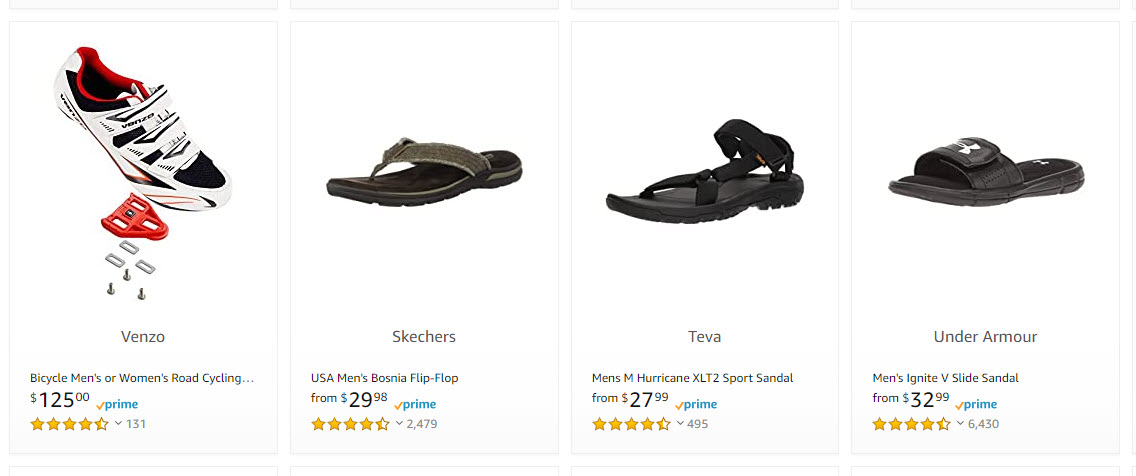
What’s Google going to do here, take the title of the various shoes? That’s even more absurd than listing locations from a list!
For the record, not all local keywords are equal in terms of average description length. As I indicated earlier, there was a tilt towards hotel keywords (i.e., best hotel and spa in houston) in the data-set (in terms of local keywords, not in terms of the data-set overall). Accordingly, I separated these keywords out from the other local keywords included.
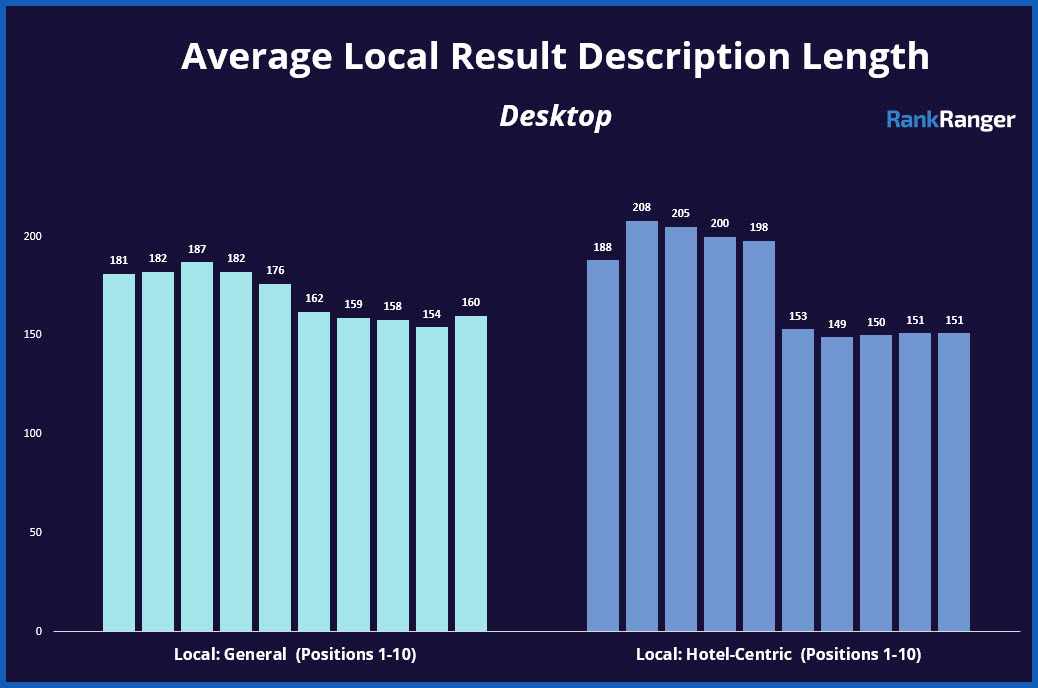
The average description length on the SERP by position (first bar of each element representing position #1 and so forth) for hotel-centric and general local queries
There is a clear jump in the average length of descriptions afforded to the results when a local hotel query is executed. Positions 2-5 on such SERPs have descriptions that are about 20 characters longer than what is shown for the same positions when looking at the local keywords I used overall.
I should add, that again, you see that clear drop off in description length occur once you reach position 6 on the SERP!
Hotel queries, like the local restaurant SERP I showed earlier, produce results whose pages often reflect lists. Just as Google did with the SERP I showed earlier, descriptions on local hotel SERPs are often filled with the list items, making these descriptions rather long at times. The same is not true for other types of local queries. For example, the SERP for pensacola dentist. Here the descriptions are generally far thinner than what we saw earlier:
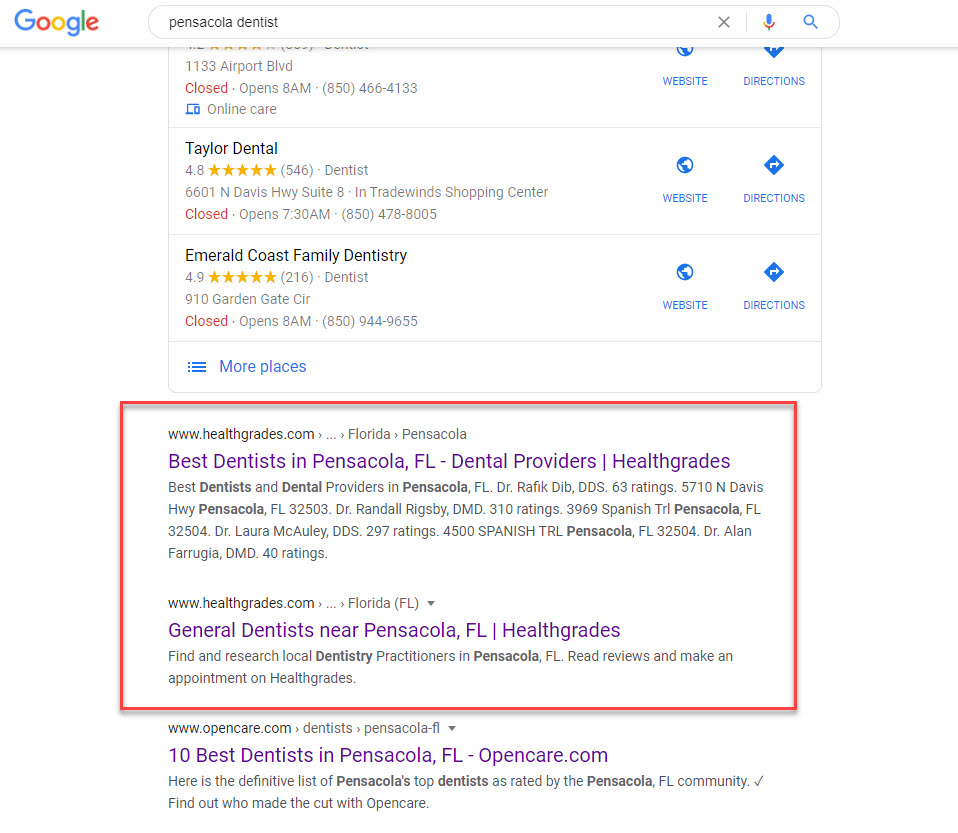
Coincidentally, so are the pages themselves. Here is what the page from the healthgrades.com site looks like:
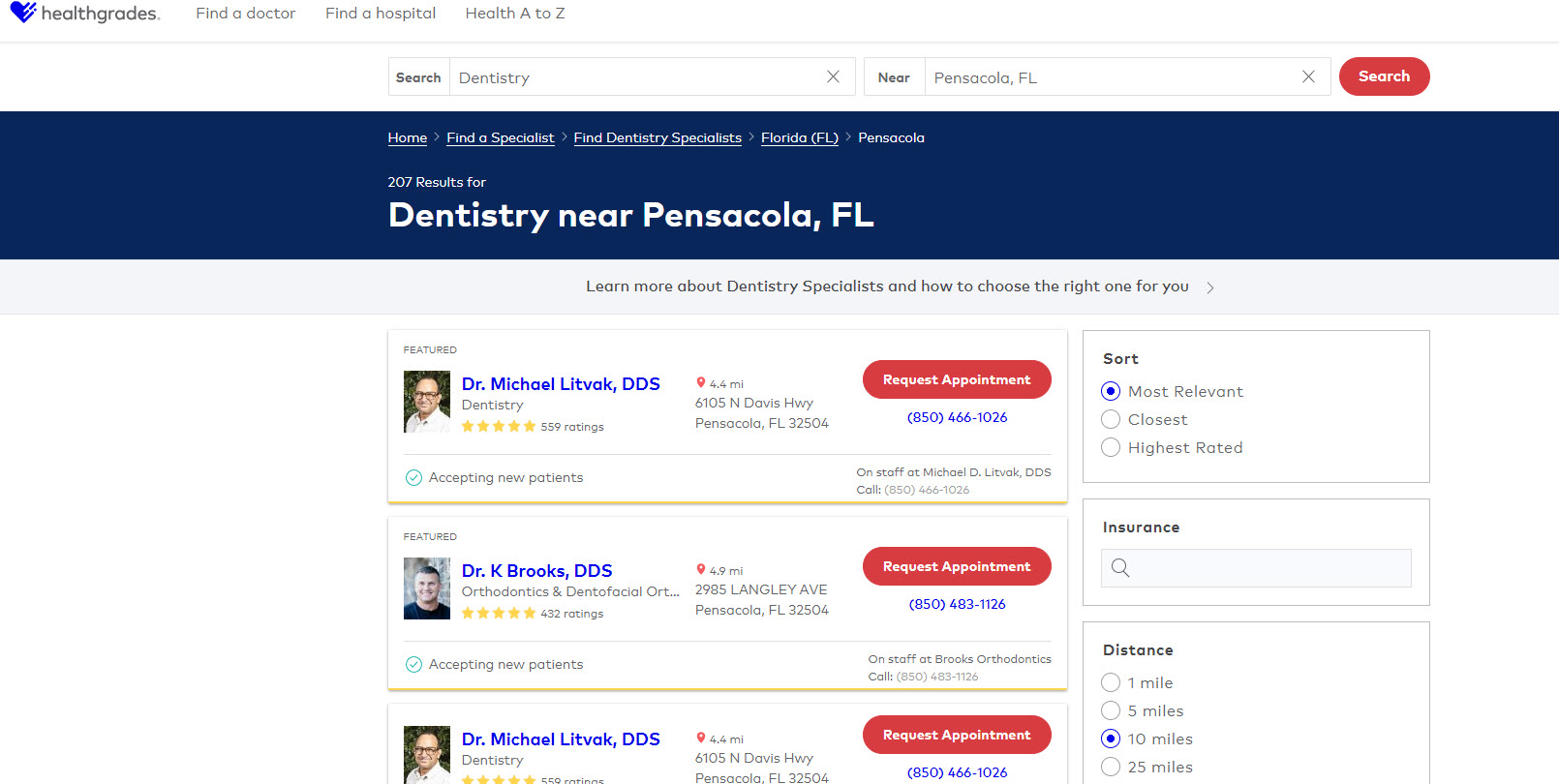
There’s really not much there. Contrast that with what one of the pages from our pizza nyc SERP shows for its lists:

Now, I don’t know why Google ignores all of the great content on the Thrillist page, including multiple paragraphs introducing the list (i.e., content not focused on just one listing). Nor do I understand why having deep content triggers a relatively useless showing of list items. Nor am I sure why in on our dentist SERP Google pulls the addresses from the list of one page, but not the other.
It could be a matter of what Google thinks the user wants in these particular cases or that it simply treats certain local industries differently than others. I have seen numerous cases where this is not what occurs. All I can say is what’s happening and what’s happening is that for certain local industries Google seems to push more list items into the descriptions shown on the SERP than it does for other local query types.
Does Google Operate with SERP Quadrants?
One of the most interesting takeaways is that it seems that Google views and relates to the top part of the SERP differently than it does the bottom. It almost seems, at least from a meta-description point of view, that Google has broken the SERP into two separate quadrants and has determined that two distinct description dynamics are appropriate for each quadrant. We’ve seen this with the overall data and with queries for both informational and local intent (with commerce queries operating on their own axis as mentioned earlier).
The question, to me, is to what extent does this concept apply? Certainly, we’ve seen similar concepts with CTR and position, but that’s not Google sailing the ship. It does make me wonder in what other ways does Google’s segmenting of the SERP impact how it operates. I did wonder if the concept applied to titles in any way, but what I found was that titles, unlike descriptions, are consistent across all positions on the page one SERP.
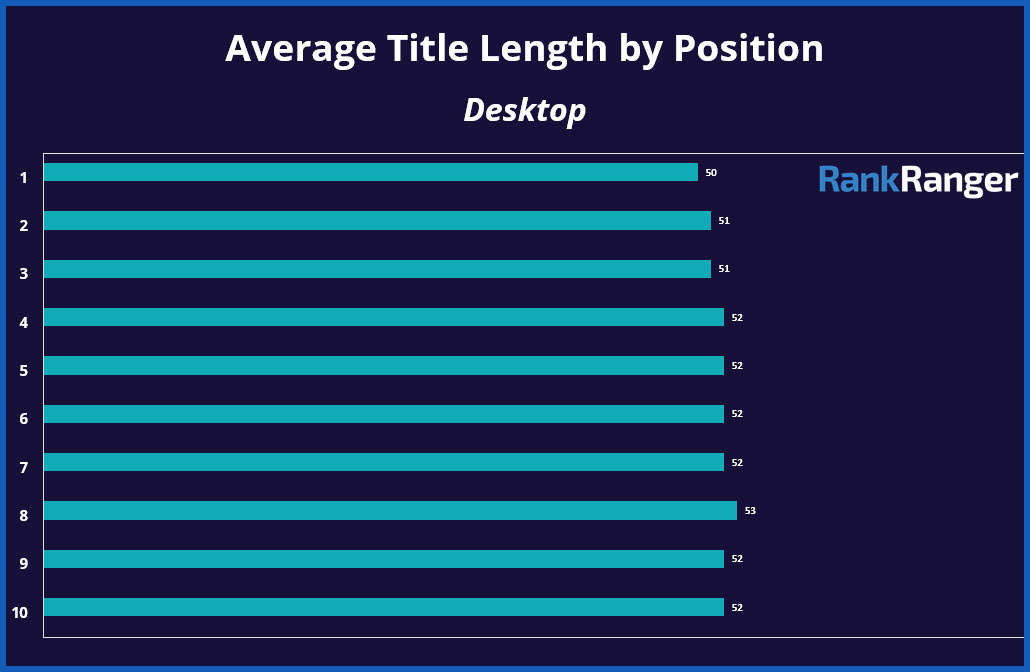
The data shows that the average length of titles on the SERP does not change in any real way from one position to the next
Description Length Differentiation Does Exist

The point of this study is not to tell you how long your descriptions are for your results at any given ranking position. I think we’ve seen that there is a lot of variation based on the query, etc. Anyway, an average is an average and there can be plenty of cases of divergence from it.
So why did I write this study?
I wrote this for two reasons. For starters, I think it’s inherently valuable to understand what’s happening on the SERP and more so to understand how Google approaches it. Seeing a clear distinction between the result description lengths by position points to Google seeing the SERP in a certain way. You can’t do SEO without understanding how the search engine thinks. This is a case of how the search engine thinks.
From a more pragmatic point of view, the study is meant to bring attention to the extent of description length differentiation on the SERP. Not in so far as telling you what you will see for your specific results, but to call attention to the fact that things may not be as they appear at first glance. If you recall, I showed an example of a SERP where a lower ranking result looked more enticing as it contained a fuller description whereas the result above it looked overly thin, if not “scrawny.” I don’t know the extent to which that influences clicks. However, I can speak to my own sentiment, and a robust description is certainly aesthetically appealing when placed next to a result whose description is starving for content.
[Much thanks goes to Levi Genesove for helping collect some of the data used in this study.]

